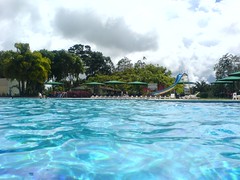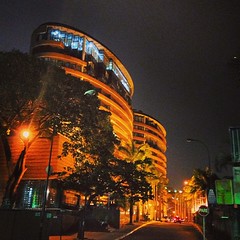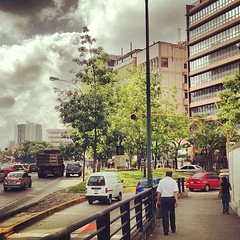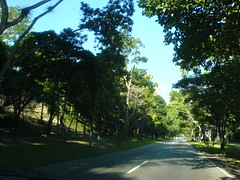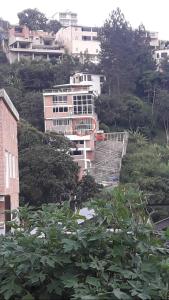Estado Miranda
Miranda State (Spanish: Estado Miranda, Spanish: [esˈtaðo miˈɾanda]) is one of the 23 states of Venezuela and the second most populous after Zulia State. As of the 2011 census, it had a population of 2,675,165 residents. It also has the greatest Human Development Index in Venezuela, according to the Venezuelan National Institute of Statistics (Instituto Nacional de Estadistica, Caracas). The most recent population estimate was 3,194,390 in mid-2016.
Miranda is an important center for political, economic, cultural and commercial activities. The state is administered by a governor, and is sub-divided into 21 municipalities, each under a mayor.
Miranda State covers a total surface area of .
History
Pre-Columbian history
When the Spanish arrived, the region was inhabited by various Caribbean tribes. Among them were the Caracas, the Teques, the Cumanagotos, the Mariches and the Quiriquires. The Teques inhabited the southwestern part of Guaire. The Mariches inhabited the eastern part of the Caracas Valley. They practiced hunting and gathering, while others lived by fishing. When the Spanish conquistadors arrived, these tribes were brave enough to fight for their territory, commanded by caciques like Guaicaipuro and Yare.
Spanish Colonization
Guaicaipuro was a legendary cacique of the Teques and Caracas Indians who resisted the conquistador Diego de Losada, while cacique Yare was the cumanagoto, quiriquire, charagoto and arauco chief who killed Captain Mendoza, who had murdered the Indian Tamanaco. Once all the tribes were subdued, the Spaniards settled completely on these lands, founding the city of Caracas, and later different towns in the interior of the state of Miranda.
During the colony this region became part of the Province of Caracas. At the end of the 16th century and beginning of the 17th century the highlands were used to cultivate, among other products, wheat destined largely for export to Cartagena de Indias and the Caribbean islands. From the second decade of the 17th century, cocoa displaced these crops. In addition, all commercial activities were monopolized by the Royal Guipuzcoa Company, which generated the first discontents and uprisings against the crown. From the beginning of the 17th century, slave labour quickly replaced the Indian labour force, concentrating on the Windward region, which was the largest cocoa producer. It was in this region that the first free blacks rose up against their masters, but were later stifled by Spanish troops.
19th Century
After the dissolution of Gran Colombia, Venezuela still used the provinces as a political-territorial organization, which had been used for a long time. Miranda, at that time, was part of a province. Between 1832 and 1855 the use of the province persisted due to the confusion generated by the existence of a state as a political division of the country.
The division by states did not appear in Venezuela in a concrete way until 1864, when about twenty states were founded which, in the following governments, would be reduced to nine, among these, the founded state of Guzmán Blanco, which by 1873 only covered the region of Aragua.
In 1881, the State of Guzmán Blanco expanded its territory to include the region of Miranda, among other nearby regions that were included as part of Guárico.
In 1889, the territory of the Guzmán Blanco State was again modified by the Constitution, and its size was reduced by excluding several regions of the country such as the region of Aragua, but renaming the State as Edo Miranda.
20th and 21st Centuries
In 1900, by decree of General Cipriano Castro, the state of Caracas was included in Miranda and Caracas was renamed Miranda State with the provisional capital in Santa Lucia. Then in 1901 the political-territorial space is modified again and the capital of the state becomes Petare, and in 1904 it is changed to Ocumare del Tuy.
In 1909 the last important modification was made, changing the capital to Los Teques.
In 1982, the municipality of Los Salias was founded through the Official Gazette of the State of Miranda.
In 1989, after the decentralization carried out by President Carlos Andrés Perez, Arnaldo Arocha was elected the first governor by popular vote.
By October 15, 2017, Héctor Rodríguez was elected governor of the State of Miranda, after facing Carlos Ocariz in an election.
Chronology
- In 1568 the mayor of Caracas, Francisco de Infante, killed the cacique Guaicaipuro, representative of the indigenous resistance in Venezuela.
- In 1572 another of the men who fought against the Spanish conquest, the cacique Tamanaco, was also killed by the conquistadors.
- In 1580 a smallpox epidemic breaks out, brought from Guinea by the black slaves, which ends the life of 20,000 aborigines in three years.
- In 1620 the process of founding new cities begins.
- In 1812 the royalists offered freedom to black slaves who took up arms against the Republicans. A general rebellion by the blacks caused panic among the landowners and led to the fall of the regime.
- In 1861, a wave of fighting broke out between the conservatives and the Feds.
- In 1841, the Federal Constitution created Miranda as an autonomous entity.
- In 1884, a plague of locusts swept through Miranda and, as the shade trees withered, ruined the coffee and cocoa plantations.
- In 1886, the Venezuelan Central Railroad entered service.
- In 1891 a new division of Miranda became part of the State of Guzmán Blanco, together with the provinces of Caracas, Aragua, Guarico and Nueva Esparta.
- In 1891 the first census was taken, more than 165,000 people lived in the current cantons of Miranda.
- In 1892, during the Legalist Revolution, various battles took place in the region between the forces of Joaquín Crespo and Raimundo Andueza Palacio.
- In 1893 the state of Miranda was formed, with the territories of Caracas (with the current state of Miranda), Guárico and Nueva Esparta.
- In 1894, the Great Venezuelan Railroad entered service.
- In 1897 the Compañía Anónima Electricidad de Caracas founded two years before by the engineer Ricardo Zuloaga installed the first hydroelectric station known as "El Encantado" located between the towns of Petare and Guarenas, thus initiating the stage of electric lighting of the city of Caracas;
- In 1899, the Mirandina territory was included in the province of Caracas.
- In 1900, by decree of General Cipriano Castro, the state of Caracas was renamed the state of Miranda, with Santa Lucía as its provisional capital.
- In 1901 a new territorial division was proclaimed that maintained the state of Miranda, with Petare as its capital.
- In 1904 the state of Miranda was maintained, with the capital in Ocumare del Tuy.
- In 1907 an iron bridge was built in Ocumare over the Tuy River, a remarkable work of engineering for the time.
- In 1909 the state of Miranda was structured as it is today, but with its capital in Ocumare del Tuy, later Los Teques was designated the capital of the state.
- In 1924 the first modern paper factory in Venezuela was installed in El Encantado.
- In 1927, the Legislative Assembly orders that the capital of the state of Miranda be moved to Los Teques.
- In 1948, according to the Law, the political-administrative division of Miranda State includes 10 districts and 35 municipalities.
- In 1957 the thermoelectric plant of La Mariposa, destined to supply energy for the pumping of water to Caracas, is put into service.
- In 1958, Guatopo National Park was declared.
- In 1967, a 6.5 Richter scale earthquake occurred, leaving 240 dead, hundreds injured and great material losses.
On Dec. 5, the Legislative Assembly of Miranda State created the Independence district, with its capital in Santa Teresa del Tuy
- In February 1989, general protests began to emerge in Guarenas due to the rise in public transport prices, which then spread to the whole country, degenerating into an uncontrolled wave of looting, called El Caracazo.
- In 1992 the state of Miranda is organized in 21 municipalities and 55 parishes.
- In 1999 heavy rains caused havoc in the region of El Guapo when the dam of the same name broke.
- In 2000 four municipalities of Miranda were integrated into the Metropolitan District of Caracas, but still part of the state of Miranda.
Geography
Location
The state of Miranda is located in the north-central part of Venezuela. It is part of the so-called Capital Region together with the Capital District and the state of Vargas. It is located in the central coastal area of the country.
It borders on the north with the Federal District, on the south with the states of Guarico and Aragua, on the east with the Caribbean Sea and on the west with Aragua. Relief The relief is predominantly rugged and abrupt, with high slopes and narrow valleys within the mountains. The eastern sector constitutes a depression in the Serranía del Litoral. The Guaire River, which runs through the city of Caracas, divides the sector into two strips that are differentiated by their decline: the Valles del Tuy and La Depresión de Barlovento.
The waters that make up the hydrographic network of the state are mostly short course. The main river basin in the State is that of the River Tuy. The availability of water resources in the state is really precarious, as the state is located in the largest urban conglomerate in the country. The volume of available water is committed to supply almost the entire metropolitan district of Caracas, as well as the entire territory of Mirandina, which is poorly supplied by the reservoirs of La Mariposa, Lagartijo, La Pereza, Ocumarito, Agua Fría, Taguaza, El Guapo and Quebrada Seca. Many of the towns in the state are not frequently supplied with drinking water due to the high consumption of water resources. The Guaire, Tuy and Grande rivers are not used because they are in a state of contamination.
Hydrography
The hydrography of Miranda State is characterized by the short course and low flow of its rivers, with the exception of Tuy. This characteristic, combined with the settlement of the largest mass of population in the country, gives its rive…
Looking for places related to Estado Miranda?
Those are other destinations to find places related to Estado Miranda:



